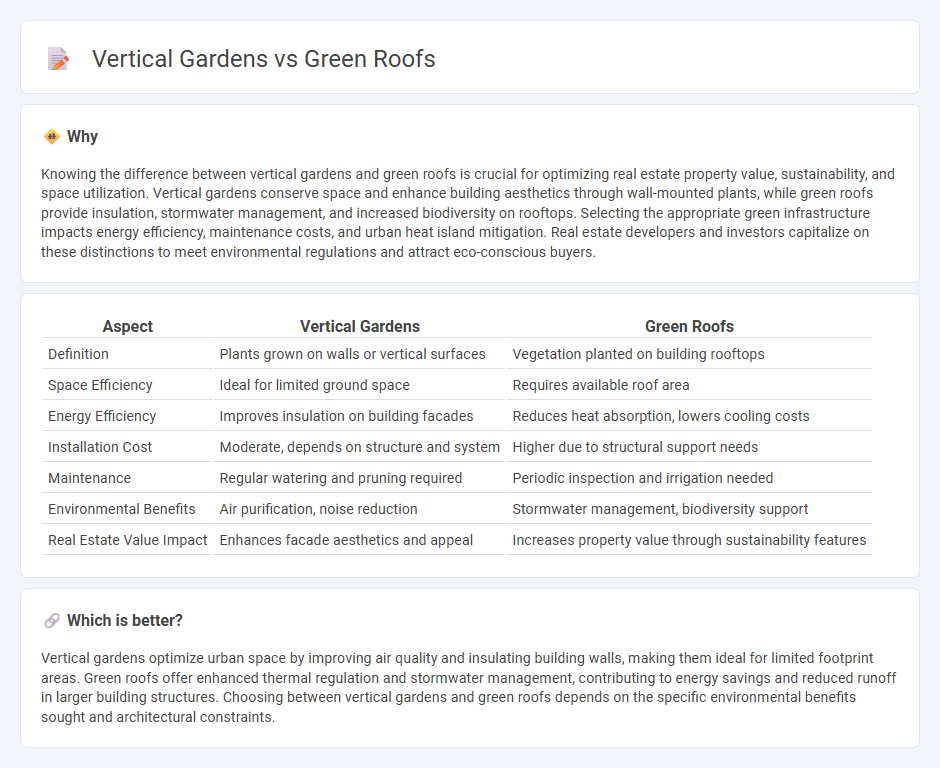
Vertical gardens maximize limited urban spaces by growing plants upward on walls, enhancing air quality and aesthetic appeal. Green roofs involve planting vegetation atop buildings, improving insulation and stormwater management while reducing urban heat island effects. Explore more about the benefits and applications of vertical gardens versus green roofs in real estate development.
Why it is important
Knowing the difference between vertical gardens and green roofs is crucial for optimizing real estate property value, sustainability, and space utilization. Vertical gardens conserve space and enhance building aesthetics through wall-mounted plants, while green roofs provide insulation, stormwater management, and increased biodiversity on rooftops. Selecting the appropriate green infrastructure impacts energy efficiency, maintenance costs, and urban heat island mitigation. Real estate developers and investors capitalize on these distinctions to meet environmental regulations and attract eco-conscious buyers.
Comparison Table
| Aspect | Vertical Gardens | Green Roofs |
|---|---|---|
| Definition | Plants grown on walls or vertical surfaces | Vegetation planted on building rooftops |
| Space Efficiency | Ideal for limited ground space | Requires available roof area |
| Energy Efficiency | Improves insulation on building facades | Reduces heat absorption, lowers cooling costs |
| Installation Cost | Moderate, depends on structure and system | Higher due to structural support needs |
| Maintenance | Regular watering and pruning required | Periodic inspection and irrigation needed |
| Environmental Benefits | Air purification, noise reduction | Stormwater management, biodiversity support |
| Real Estate Value Impact | Enhances facade aesthetics and appeal | Increases property value through sustainability features |
Which is better?
Vertical gardens optimize urban space by improving air quality and insulating building walls, making them ideal for limited footprint areas. Green roofs offer enhanced thermal regulation and stormwater management, contributing to energy savings and reduced runoff in larger building structures. Choosing between vertical gardens and green roofs depends on the specific environmental benefits sought and architectural constraints.
Connection
Vertical gardens and green roofs both enhance urban real estate by improving building energy efficiency and increasing property value through sustainable design features. These green installations reduce heat absorption, mitigate stormwater runoff, and provide natural insulation, lowering energy costs for heating and cooling. Incorporating living plants in real estate development supports biodiversity and promotes healthier environments, attracting eco-conscious buyers and tenants.
Key Terms
Stormwater Management
Green roofs and vertical gardens both enhance stormwater management by absorbing rainfall and reducing runoff; green roofs utilize extensive substrate and vegetation layers to capture and delay water discharge, while vertical gardens rely on specialized planting media and irrigation systems to retain and filter rainwater. Studies indicate green roofs can retain up to 75% of precipitation, significantly decreasing urban flooding risks, whereas vertical gardens improve water quality by filtering pollutants through plant roots and substrates. Explore comprehensive benefits and design strategies of green roofs and vertical gardens for effective stormwater solutions.
Thermal Insulation
Green roofs provide excellent thermal insulation by creating a natural barrier that reduces heat absorption, lowering indoor temperatures and decreasing energy costs. Vertical gardens enhance insulation by shading walls and reducing temperature fluctuations, contributing to improved building energy efficiency. Explore further to understand which option best suits your thermal insulation needs.
Urban Biodiversity
Green roofs and vertical gardens significantly enhance urban biodiversity by creating habitats for various species in densely populated areas. Green roofs support pollinators like bees and butterflies through diverse plantings, while vertical gardens provide vertical layers of vegetation that attract birds and insects, contributing to ecological connectivity. Explore more to understand how these innovative urban greening solutions foster sustainable biodiversity.
Source and External Links
Green Roof - Wikipedia - A green roof is a roof covered with vegetation and a growing medium, providing benefits like insulation, stormwater management, and habitat creation.
Green Roofs: Benefits and Design Considerations - Green roofs are effective for stormwater management, reducing runoff and improving urban sustainability through extensive and intensive designs.
Advantages and Disadvantages of Green Roofs - Green roofs offer numerous advantages, including improved energy efficiency, enhanced environmental benefits, and support for wildlife habitats.
 dowidth.com
dowidth.com